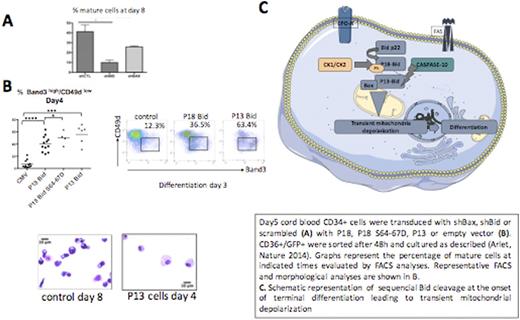Abstract
Late stage of erythroidmaturation requires transient mitochondria depolarization (DYM) leading to caspasesactivation without apoptosis (Zermati, J Exp Med 2001). Thus, the control ofDY M (transient vs irreversible) determines the fate of erythroblast (Differentiaiton vs Apoptosis). Here we show thatDY Mduringdifferentiation is associated to a conformational change ofBax, which is dependent on Bid but neither onBim nor Puma. Likewise, decrease expression ofBax or Bid bylentiviral transduction oferythroid progenitors withshRNAs inhibit bothDY Mand terminalerythroid differentiation (ED) (figA). These results suggest that the extrinsic pathway of apoptosis is involved in ED.Caspase-10 but not caspase-8 is cleaved at the onset of terminal ED and its inhibition in immature erythroblasts withshRNA induced an end-stage maturation arrest and apoptosis.
Both caspase-8 and caspases-10 can cleave Bid on LQTD-60 site, generating the typical proapoptoticP15 tBidfragment. This cleavage exposes a glycine residue to N-myristoylation, targeting Bid to mitochondria and promoting apoptosis. Caspase-10 can also recognize the IEAD-75 site, resulting in the generation of a P13 fragment. To determine whether Bid is cleaved during ED, we performed immunoblotanalyses on non-apoptotic sorted erythroidcells at different stages of maturation. We showed that Bid is sequentially cleaved during ED, generating two major truncated forms of 18 and 13 kDa, respectively. The truncated P18 Bid could result from a putative caspase-10 cleavage site located on RELD-38 and has never been described. To investigate the contribution of each Bid fragment on ED, we design N-terminal deletion mutants of Bid, starting on residue 39 (DEL38) or residue 76 (DEL75), generating Bid P18 and Bid P13 respectively, cloned in a lentiviralvector. While P18 overexpression induced apoptosis in 40% of erythroidcells, P13 did not and inducedouter DYMwithin a few hours. In contrast, both deletion mutants induced full ED after 3 days of culture compared to 8 days in controls, as shown by morphological and FACS analyses that show a higher percentage of Band3high/CD49dlow population (4.4% for control vs 39.35% for P18 p<0.0001 and 62.55% for P13 mutant P=0.0005 (figB).
It has been demonstrated in vitro that Bid is protected from caspase-8 cleavage through its phosphorylation by casein kinases 1 and 2 (Desagher, Mol Cell 2001). Using anti-phospho-serine BID antibodies, we showed that P18 is phosphorylated during ED. We performed site directed mutagenesis on potential phosphorylation serine residues: both S64 and S67 were converted to aspartate to mimic a phosphorylation. These mutations were introduced into P18 and were transduced into erythroid cells. We observed a significant higher percentage of Band3high/CD49dlow population in P18:S64-67D transduced cells compared to P18 control cells (51.1% vs 39.35% respectively, P=0.028figB), while apoptosis was significantly reduced in P18-S64-67D cells. This suggests that phosphorylation on these residues is protective from apoptosis and allows terminal differentiation to occur. Finally, we demonstrated that CK1 inhibition induced a decrease in Bid P18 phosphorylation and induced apoptosis.
We propose a model in which caspase-10 is activated at the onset of terminal differentiation cleaving Bid first on D38 residue generating P18. This form is phosphorylated by CK1, anEpodependent gene, on serine residues 64 and 67, protecting from cleavage at D60 that generates the apoptotic P15tBid. PH-P18 is ultimately cleaved at D75 residue generating P13, which cannot be N-myristoylatedand activatesBaxthereby inducing a transient and not irreversibleDYMand terminal ED (figC). Therefore, the level of Bid phosphorylation and its resulting cleavage pattern determines the fate of erythroblasts (apoptosis vs differentiation).
We suggest that in MDS 5q- with CK1haploinsufficientexpression,Bidcould beunderphosphorylated, and that by inducing CK1 degradation,lenalidomidecould inhibit Bidphosphorylationsgenerating the P15tBidand inducing apoptosis of 5q- clones.
Hermine:AB science: Consultancy, Equity Ownership, Membership on an entity's Board of Directors or advisory committees, Patents & Royalties, Research Funding, Speakers Bureau; Novartis: Research Funding; Celgene: Research Funding; Alexion: Research Funding.
Author notes
Asterisk with author names denotes non-ASH members.


